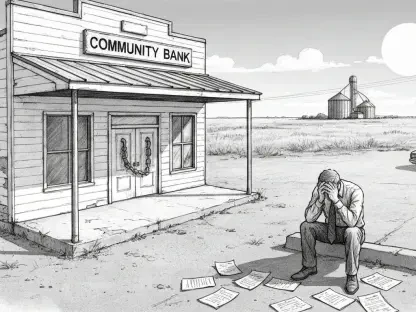As the euro zone navigates a complex economic landscape marked by persistent uncertainties and steady projections, the European Central Bank (ECB) finds itself at a critical juncture in determining the future of monetary policy. With inflation hovering near target levels and growth forecasts showing only modest improvement, policymakers face mounting questions about whether current interest rates should remain unchanged or if a shift is warranted. Gabriel Makhlouf, a key member of the ECB Governing Council and Ireland’s central bank chief, has recently shed light on this dilemma, emphasizing a cautious, evidence-based approach. His insights reflect a broader sentiment within the ECB, where stability is prioritized over reactive measures, even as global risks loom large. This article delves into the ECB’s current stance, exploring the rationale behind maintaining steady rates and the potential triggers that could prompt a policy pivot.
Current Monetary Policy Stance
Assessing the Status Quo
The ECB’s monetary policy remains firmly rooted in a wait-and-see approach, with interest rates holding steady since the last adjustment several months ago. Makhlouf has expressed satisfaction with the current levels, describing the policy as being in a “good place” for the time being. This perspective aligns with the broader consensus among ECB policymakers who are reluctant to make changes without substantial evidence of a shift in the economic outlook. The euro zone economy is performing largely as expected, with projections indicating continuity rather than dramatic deviation. This stability provides a foundation for the ECB to avoid hasty decisions, focusing instead on long-term trends over short-term fluctuations. Financial markets appear to echo this sentiment, with investors assigning a low probability to an imminent rate cut at the next ECB meeting, signaling confidence in the current framework despite murmurs of potential adjustments in the distant future.
Balancing Stability and Flexibility
While the ECB is content with the present state of monetary policy, there is an underlying recognition of the need for adaptability in an unpredictable global environment. Makhlouf has underscored the importance of a meeting-by-meeting approach, allowing the ECB to respond to emerging data without being locked into a rigid trajectory. This flexibility is critical given the array of external risks, from geopolitical tensions to disruptions in international trade, that could swiftly alter economic conditions. Unlike some central banks that might preemptively adjust rates based on speculative forecasts, the ECB’s strategy hinges on concrete evidence, ensuring that any decision to cut or raise rates is grounded in reality. This cautious yet dynamic posture reflects a deliberate effort to safeguard the euro zone’s economic stability while remaining poised to act if circumstances demand a recalibration of policy.
Economic Outlook and Potential Triggers
Inflation Dynamics and Policy Implications
Inflation remains a pivotal factor in the ECB’s decision-making process, yet Makhlouf has adopted a notably measured stance on recent projections. With forecasts suggesting a temporary dip below the 2% target in the near term, followed by a rebound in subsequent years, there is little cause for immediate alarm. The emphasis is on understanding the root causes of these fluctuations rather than reacting to minor deviations, such as a projected rate of 1.8%, which is not seen as a significant concern. This approach highlights a broader philosophy within the ECB to prioritize sustainable trends over transient data points. By maintaining focus on underlying economic drivers, the ECB aims to avoid overcorrecting in a way that could destabilize the euro zone’s recovery. As fresh projections are set to be released soon, including figures extending to 2028, the anticipation is for continuity rather than surprises, further reinforcing the current policy stance.
Growth Forecasts and External Risks
Economic growth in the euro zone is expected to hover just above 1% for the foreseeable future, a modest figure that neither alarms nor inspires significant policy shifts. This steady, albeit slow, growth trajectory supports the ECB’s inclination to hold rates steady unless a more pronounced change emerges. However, Makhlouf has acknowledged a constellation of risks that could upend this outlook, including overvalued assets in major markets, declining credit standards, and the rapid rise of opaque financial sectors. Add to this the ongoing geopolitical challenges and political uncertainties, and the potential for sudden economic disruption becomes evident. These factors collectively underscore the importance of vigilance, ensuring that the ECB remains prepared to pivot if any of these risks materialize into tangible threats. While the current data does not warrant immediate action, the complexity of the global landscape keeps the possibility of a rate adjustment on the table should conditions deteriorate unexpectedly.
Reflecting on a Prudent Path Forward
Looking back, the ECB’s journey through recent economic challenges demonstrates a steadfast commitment to stability, guided by the insights of policymakers like Makhlouf who champion a data-driven approach. The decision to maintain interest rates reflects a careful balance between responding to immediate economic signals and preparing for long-term uncertainties. Moving forward, the focus should shift toward enhancing predictive models and deepening analysis of global risks to better anticipate potential disruptions. Strengthening collaboration with international financial bodies could also provide a buffer against external shocks, ensuring the euro zone remains resilient. As new economic projections emerge, the ECB must continue to prioritize evidence over speculation, paving the way for informed decisions that safeguard growth while addressing inflation dynamics. This prudent path, rooted in adaptability and caution, offers the best chance to navigate the evolving economic terrain with confidence.









